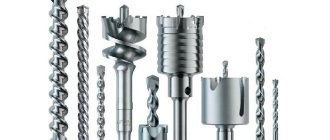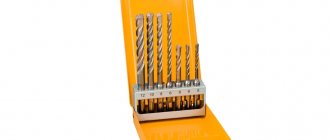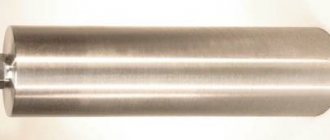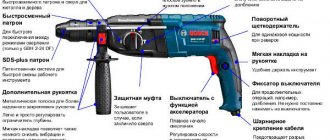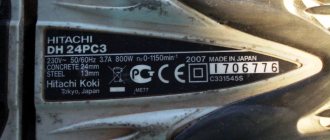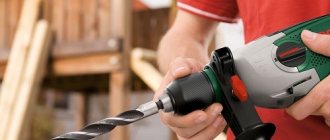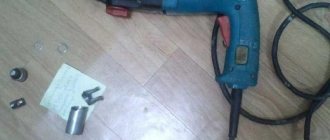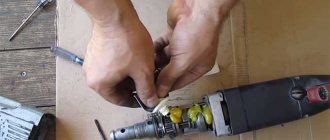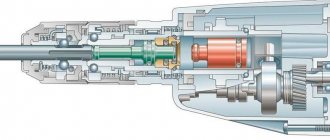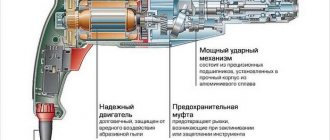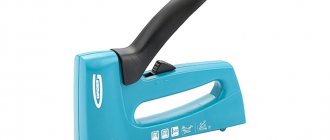Drills for concrete hammer drills: parameters and selection rules
A concrete hammer drill is a metal tool that can be successfully used for drilling holes in structures also made of brick, natural and artificial stone.
Concrete drills are used in construction and repair work and are classified according to various parameters: design, power of the equipment on which they are installed, type of shank, as well as the geometric parameters of their spiral part.
The right drill can be selected for each specific task
Important parameters
Without drilling holes in various surfaces, construction and repairs are impossible. And if a regular electric drill is quite suitable for making holes in a structure made of wood materials, brick and plasterboard, then only a hammer drill can cope with a concrete structure.
The peculiarity of this equipment is that it can not only drill the surface being processed, but also exert an impact load on it, that is, perform the function of a jackhammer. Naturally, to install it on a hammer drill you need to use a special tool - a drill.
It differs from a conventional metal drill in a number of parameters.
The drills differ from each other in their design features, among which the following should be highlighted:
- design of the spiral part;
- the presence of a special cavity in the inner part;
- material for manufacturing the working part, which can be a hard alloy;
- number and geometric parameters of cutting edges.
Main parts of the drill
Drills are also distinguished from ordinary drills by the design of the shank, which allows them to be securely fixed in the chuck of the equipment used. The most common types of concrete drill shanks and chucks used when working with rotary hammers are the following.
SDS+
SDS-plus drills, like cartridges in this category, are designed for installation on medium and light series rotary hammers. It is devices of this type that are most often used by home craftsmen to perform various repair and construction work. The diameter of the SDS-plus shank cannot exceed 18 mm.
Drills with this shank are designed for light construction hammer drills
SDS-max
Intended for concrete processing, drills with shanks of the SDS-max category (the diameter of their fastening part exceeds 18 mm) are used in the configuration of professional series rotary hammers.
The SDS-max system with an increased contact area of the wedges is designed for heavy hammer drills
The main manufacturers of SDS-plus concrete drills (the most popular category) are Chinese companies.
As a rule, the parameters of such products comply with the requirements set by GOST, so they can be installed on any rotary hammers.
Meanwhile, you should not try to insert a tool for working with concrete into a regular drill, since it will not be possible to do this even with considerable effort.
To choose the right drill for a hammer drill, you should take into account such parameters of the working part as:
- length, the size of which determines how deep the hole you can drill;
- diameter.
Operating parameters of the drill
Taking into account the fact that hammer drills are used to work with particularly durable materials (concrete, natural and artificial stone), their design has a reinforced design, and the working part is made in the form of a double spiral.
This is what allows you to use hammer drills when working with concrete and other materials for a long time, without worrying about their technical condition.
Many models of concrete drills for rotary hammers are equipped with a tip made of the strongest alloy of the VK8 brand, which allows them to be successfully used for processing materials of particularly high strength.
Selecting tools of this type is not difficult: all of their most significant parameters are indicated in the labeling. For example, if in front of you is a concrete drill marked 6x160, this means that it has the following dimensions: working diameter - 6 mm, length - 160 mm. It must be borne in mind that the marking of the tool indicates its working length, which is slightly smaller than the dimensions of the working part.
The diameter of the working part of concrete drills installed on a hammer drill can be in the range of 4–30 mm. The most popular sizes fall in the range of 6–10 mm. Using a concrete drill of this size, you can, in particular, make a hole for placing a dowel.
How to choose the right drill
The choice of drill to equip a hammer drill should take into account the strength of the material in which the hole needs to be made.
The degree of steepness of the spiral part is also of great importance: the larger it is, the deeper the hole can be drilled at a higher speed.
When using a tool with such characteristics, waste material is more efficiently removed from the processing area, which allows you to work very quickly.
How to choose a drill for concrete? It is advisable to rely on the advice of specialists with experience in construction and repair work.
- For drilling shallow holes in concrete, a tool with a flatter spiral is suitable, which is also stronger and more durable.
- It is always better to choose tools from trusted manufacturers, since products from little-known brands are not always of decent quality and may not be suitable for hammer drill cartridges.
Concrete structures are drilled with a perforator, not drilled. The main requirement for a drilling tool is reliability
When purchasing a drill for a hammer drill, you should take into account not only GOST, but also the price category of the tool. On the modern market, you can choose both expensive drills for professional use and cheap disposable ones that do a good job with the tasks. High quality at an affordable price for concrete drills produced under the Bosch, Sturm and Makita brands.
Depending on their purpose, drills for rotary hammers are divided into several categories. Screw
These tools, ideal for drilling holes of considerable depth with a hammer drill, due to their design features, create a minimal amount of dust during operation and do not put a large load on the hammer drill.
Auger drill with carbide inserts
With a significant inclination of the working groove
The use of tools of this type allows drilling to be performed at high speed, which significantly increases the productivity of this process. When deciding to choose a drill for a hammer drill of the specified type, you should keep in mind that such a tool creates a significantly greater load on the equipment used than an auger one.
With a slight inclination of the working groove
Tools of this type, provided they are used with light loads, have an increased service life.
Crowns
These tools are used to create large diameter holes in concrete. This can be either a diamond drill or a drill, the working part of which is equipped with cutting plates made of hard alloy.
Drill bit with carbide cutters
It is recommended to apply lubricant to the shanks of drills installed in a hammer drill, then the tool will last much longer and its use will be more efficient.
Drills installed on a hammer drill for concrete processing are divided into two main types:
- breaking (needed to make large diameter holes in concrete);
- walk-through (they have great power and allow you to make holes even in load-bearing concrete walls of building structures).
Heads of through-and-break drills provide precise punching due to the centering rod and rapid advancement due to chisel-shaped cutters
Drills and drills: differences
The main difference between a drill and a conventional drill is the design of the shank, which has a special groove. It is precisely because of the presence of such a groove that the drill cannot be inserted into the chuck of an electric drill. In addition, the distinctive features of the drills include:
- increased rigidity, which makes it possible to successfully drill even very durable materials;
- high productivity, which is achieved due to the fact that drilling is carried out with the simultaneous application of a shock load to the material being processed.
A shank with certain grooves is the visible and main difference between hammer drill bits and drill bits
To reliably fix the concrete drill in the hammer drill chuck, as well as to quickly replace it with the selected tool, the SDS fastening system (SDS), developed by Bosch specialists, is used.
Depending on the category of the hammer drill and the type of drill used, a fastening system of one of five types can be used to fix the latter. SDS
This system is used to hold tools with a shank diameter of 10 mm (this shank has two grooves).
SDS-plus
This is the most popular category of fastening devices, also used to secure tools with a shank diameter of 10 mm in a hammer drill. The SDS-plus shank has not two, but four grooves, two of which are closed.
SDS-top
This is a not very common category of fastening systems used to secure tools whose shank has a diameter of 14 mm. Devices of this type are used to complete rotary hammers of medium weight category.
SDS-max
Such devices are used to complete powerful rotary hammers of the professional series. They are equipped with drills with a shank diameter of 18 mm.
SDS-quick
This not very common category of fastening systems is notable for the fact that on the shank of the tools for which it is intended to secure, there are not grooves, but protrusions.
This type of shank was used in Bosch Uneo rotary hammers
When deciding which drills are best for equipping a rotary hammer, you must first focus on the tasks that you are going to solve. According to this, you can choose a drill:
- for drilling holes of small diameter (its cutting edges are slightly rounded, which makes it possible to give it higher strength);
- crown type, with the help of which large-diameter holes are created (for example, a diamond drill).
Adapters are used to install a drill with a non-native shank into a hammer drill.
Drill design features
What is the design of any concrete drill used to complete a hammer drill?
Shank
Using this structural element, the tool is fixed in the hammer drill chuck. Depending on the category of the fastening system, as mentioned above, drill shanks may have significant design differences.
Body
This structural part bears the main load. To ensure high reliability of the drill body, especially strong grades of steel are used for its manufacture.
Cutting part This element performs the main work of drilling holes. Depending on the purpose of the tool, its cutting part may have a different design and be made of different materials. Cutting parts are produced with diamond coating (diamond drill), as well as from carbide plates.
Diamond bit set for rotary hammer
Tool dimensions
To choose the right drill for a hammer drill, you should focus on three main parameters: the diameters of the shank and working part, and the working length. All sizes of drills are specified by the corresponding GOST, which greatly simplifies the choice.
When purchasing a tool of a certain diameter for a hammer drill, you can rely on the following recommendations.
- To perform housework, as a rule, drills with a diameter of 6, 8 and 10 mm are used.
- To drill holes for fastening massive and heavy objects, drills with a diameter of 10 and 20 mm are used.
Categories of concrete drills
Drills for concrete hammer drills, the dimensions of which are also regulated by GOST, consist of:
- spiral-shaped rod;
- cutting part;
- shank.
Drills for concrete work can be divided into three main categories:
- self-sharpening (specially designed for drilling deep holes with a hammer drill; when used, broken and crumbled concrete is well removed from the hole);
- spiral (highly efficient when dismantling massive concrete structures);
- with a flat arrangement of the spiral part (such drills, which require significant effort during use, are used for drilling shallow holes).
Concrete drill for professional use with double helix
You should also highlight a diamond drill, with which you can drill concrete structures reinforced with metal reinforcement. A diamond drill can significantly increase the productivity of work performed, but it must be taken into account that the cost of diamond drills for concrete is quite high.
There are also special types of drills, the requirements for the parameters of which are also specified by the corresponding GOST. These include, in particular:
- crowns;
- chisels;
- channel drills;
- flat chisels.
Drilling wood
In some cases, for drilling products made from wood materials, it is better to use not a standard drill, but a special wood drill. Using such a tool allows you to achieve the following advantages.
- Chips are removed from the processing area more efficiently.
- You don't need to put a lot of effort into forming a hole.
- The structure of the wood is not destroyed, since a clean drilling cutter is used as the tip of such a drill.
Source: https://met-all.org/oborudovanie/prochee/bur-dlya-perforatora-po-betonu-razmery-sds.html
GOST 6086—75
USSR STATE COMMITTEE ON STANDARDS
Editor R. G. Govsrdovskaya Technical editor L. V. Weinberg Proofreader L. A. Tsareva
Slano in dad. (PO! 82 Poda, printed 01/07/82 0.875 i. g t. 0.28 uch lpd l. Tar. 6000 Price
Order “Badge of Honor” Standard Publishing House, Moscow, D-557, Povoprsspepskpp per., b il mposskaya i ipsh rafpn I 1dat elstva s g ap dar goi, st. Mi i da u so, 12/11 Zak.
UDC 622.233.051 : 006.354 Group G41
STATE STANDARD OF THE USSR UNION
DRILLING BITS FOR PERFORATORS Technical requirements
Bits for drills Technical requirements * 1
GOST 6086-64 regarding technical requirements
By Decree of the State Committee of Standards of the Council of Ministers of the USSR dated December 9, 1975 No. 3827, the introduction date was established
Verified in 1981. Validity period extended to 01/01. 1987
Failure to comply with the standard is punishable by law
This standard applies to drill bits in accordance with GOST 17196-77.
1. TECHNICAL REQUIREMENTS
1.1. Crown bodies must be made of steel grades 35KhGSA, 20Kh2N4A, 18Kh2N4MA, 18Kh2N4VA or 38KhNZMFA in accordance with GOST 4543-71. The use of steel of the specified grades treated with synthetic slag is allowed.
1.2. For reinforcement of drill bits, carbide products of grades VK8V, VKPV or VK15 should be used according to GOST 3882-74.
1.3. The hardness of crown bodies made of steel grades 35KhGSA and 20Kh2N4A must be HRC 35. . . 45, from steel grades 18Kh2N4MA, 18Kh2N4VA and 38KhNZMFA - HRC 32. . . 42. For crowns with a threaded hole in accordance with GOST 17196-77, it is allowed to increase the upper limit of hardness to HRC 50.
(Changed edition, Amendment No. 1).
1.4. The roughness parameters of crown surfaces according to GOST 2789-73 should be:
landing cone. 12.5 µm;
thread. ^2^20.0 µm;
sharpened surfaces of carbide products. /?r^10µm;
_blade ribbons. Ra^t25 µm._
Official publication Reproduction prohibited
* Reissue September 1981 with Amendment M 1 approved in May 1981 (ICC No. 7 of 1981).
© Standards Publishing House, 1982
1.5. The radial runout of the outer surface of the crowns along the largest diameter should not exceed 0.5 mm.
1.6. The blades of carbide products of multi-edge crowns and the extreme lateral points of the cutting edge of chisel crowns must lie in the same plane, perpendicular to the axis of the crown. The permissible deviation is no more than 0.5 mm.
1.7. The difference in the thickness of the crown shank in a section perpendicular to the axis, except for sections passing through flats, should not exceed 0.5 mm.
Read also: How to weld aluminum using conventional welding
1.8. Carbide products must be subjected to vibration-volume processing.
1.9. Before soldering, the housings of the bits must be degreased.
1.10. The strength of the soldered seam of crowns, except for KDP type crowns, must ensure drilling of at least 400 mm of rock with a strength coefficient f = 16-18 or 800 mm of rock with a strength coefficient f = 12-14 on the professional scale. M. M. Protodyako-nova.
The shear strength of the soldered seam of KDP type crowns under static load must be at least 150 MPa (15 kgf/mm 2 ).
1.11. Brass of grade L63 in accordance with GOST 15527-70, solder of grade PrMNMTs 68-4-2 or LNKoMTs 49-9-0.2-0.2 should be used as solder, and technical borax as flux should be used in accordance with GOST 8429-77.
1.12. The solder should fill the gap between the housing groove and the carbide without breaking. Visible unsoldered joints with a total length of no more than 5% of the perimeter of the soldered seam are allowed.
1.13. Carbide products in finished crowns should not have cracks and burns from sharpening, as well as chipping exceeding the dimensions specified in GOST 4411-79.
1.14. The blade of the crown should have a ribbon of 0.5-1.0 mm or a radius of 0.5-1.0 mm; the ends of the blades along the periphery should have chamfers measuring up to 1 mm at an angle of 45° to the axis of the crown.
1.15. Each batch of crowns is up to 1500 pcs. accompanied by instructions for use.
2. ACCEPTANCE RULES
2.1. To verify compliance of manufactured crowns with the requirements of this standard, the manufacturer must carry out acceptance inspection and periodic testing.
2.2. Acceptance inspection should be carried out with the following sample size:
for compliance with the requirements of paragraphs. 1.12; 1.13—100% crowns;
for compliance with the requirements of paragraphs. 1.5; 1.6; 1.7; 1.14—5% of crowns, but not less than 3 pieces. from the party;
For compliance with the requirements of clause 1.4—10 crowns per batch;
for compliance with the requirements of paragraphs. 1.3; 1.10, except for KDP type crowns - 2 pcs. from batch up to 6000 pcs.;
for compliance with the requirements of paragraphs. 1.3; 1.10 bits of the KDP type: for automatic soldering—3 bits per batch, from each soldering installation;
for manual soldering - 0.3% of the batch* but not less than 3 pcs.
The batch must consist of crowns of the same standard size* from the same material, manufactured in one shift, simultaneously presented for acceptance according to one document.
2.3. If the results of the acceptance control are unsatisfactory for at least one of the indicators, repeated control is carried out on twice the number of crowns from the same batch.
The results of the re-inspection are final and apply to the entire batch.
2.4. Periodic tests must be carried out at least once every 2 years on at least 20 crowns.
2.5. During periodic testing, crowns must be monitored for compliance with the requirement of clause 5.2.
2.6. The results of periodic tests must be documented in the form of a report. At the request of the consumer, the manufacturer is obliged to present test reports.
3. TEST METHODS
3.1. The hardness of the body must be determined after removing a surface layer with a thickness of at least 1 mm at a distance of at least 15 mm from the end of the crown shank and at least at three points evenly spaced along the length of the crown. Hardness measurement - according to GOST 9013-59.
3.2. The shear strength of the solder joint (clause 1.10) must be checked on testing machines in accordance with GOST 7855-74.
3.3. Drilling tests of the strength of the soldered seam (clause 1.10) of crowns with a diameter of 28-40 mm are carried out using hammer drills with an impact energy of at least 60 J (6 kgf * m) at a compressed air pressure of 0.5 MPa (5 kgf / cm 2) according to GOST 10750- 80, with a diameter of 43-60 mm - with an impact energy of at least 90 J (9 kgf*m) at a compressed air pressure of 0.5 MPa according to GOST 18092-79, with a diameter of 65-85 mm - with an impact energy of at least 150 dJ (15 kg-m) at a compressed air pressure of 0.5 MPa according to GOST 18092-79.
3.4. Control of the non-solder (clause 1.12) must be carried out by external inspection and measurement of the length of the non-solder. 4
4. LABELING, PACKAGING, TRANSPORTATION AND STORAGE
4.1. (Deleted, Amendment No. 1).
4.2. Each crown must be preserved in accordance with GOST 9.014-78. The shelf life of the product is 3 years under category Z storage conditions.
(Changed edition, Amendment No. 1).
4.3. Crowns of the same standard size and design must be packed in boxes in accordance with GOST 2991-76, 50-250 pieces each. gross weight not more than 80 kg. The packaging must be tight, preventing the movement of the bits inside the box and the contact of carbide products. By agreement with the consumer, crowns can be transported without packaging.
Read also: Battery charging device
4.4. Each box must contain a document with the following information:
trademark of the manufacturer;
symbol according to GOST 17196-77;
carbide grade;
number of products in the box;
The lid and side walls of the box must be marked in accordance with GOST 14192-77 p with the trademark of the manufacturer.
(Changed edition, Amendment No. 1).
4.5. During transportation, crowns must be protected from precipitation. 5
5. MANUFACTURER WARRANTY
5.1. The manufacturer must ensure that the crowns comply with the requirements of this standard provided that the consumer complies with the operating and storage conditions.
5.2. The manufacturer must guarantee at least three periods of durability of bits with conical connecting holes and four periods of durability of bits with threaded connecting holes when drilling medium- and highly abrasive rocks with a hardness coefficient / = 12-14 on the professional scale. M. M. Protodyakonov perforators, the impact energy of which, depending on the diameter of the crowns, must comply with the requirements of clause 3.3.
(Changed edition, Amendment No. 1).
Change No. 2 GOST 6086-75 Drill bits for rotary hammers. Technical requirements
By Decree of the USSR State Committee on Standards dated December 20, 1986 No. 4239, the introduction date was established
Clause 1.2 after the word “products” should be stated in a new edition: “according to GOST 850-75 grades VK15, VK8V, VKYUKS, VKPV according to GOST 3882-74.”
Clause 1.3. Replace values: HRC 35. 45 on HRC3 37. . . 46.5; HRC 32. 42 on HRC* 34 . 43.5; HRC 50 to HRC3 51.5.
Clause 1.4 shall be stated in a new wording: “1.4. The roughness parameter Ra of crown surfaces according to GOST 2789-73 should be, microns, no more than:
thread seat cone
(Continued on page 208)
Note. It is allowed to use sharpened carbide products with a surface roughness parameter Ra of no more than 1.6 microns"
Clause 1.6 should be deleted.
Clause 1.11 should be supplemented with the words: “Fluxes of grades PV 200, PV 201 according to GOST 23176-78.”
Clause 1 13. Replace the reference: GOST 4411-67 with GOST 4411-79.
Section I should be supplemented with clause 1.16: “1.16. The average resource of bits when drilling rocks with a strength coefficient f = 12-14 on the prof. scale. M M. Pro-todyakonova hammer drills with impact energy corresponding to the requirements of clause 3.3 must be, m, not less than:
for KDP type crowns for KKP type crowns for KTSh type crowns for KNSH type crowns
(Continued on page 209)
Clauses 2L, 2.3 shall be stated in a new edition: “2.1. Acceptance inspection and periodic testing shall be carried out to verify that bits comply with the requirements of this standard.
2.3. If, during the acceptance inspection, it is established that more than one bit does not comply with the requirements of the standard in at least one controlled parameter, then the batch will not be accepted.
(Continued on page 210)
If it is determined that one crown does not comply with the standard requirements for at least one controlled parameter, then repeated control is carried out on a double number of crowns. If there are defects in the re-sampling, the batch will not be accepted.”
Clause 2.5. Replace link: clause 5.2 with clause 1L6.
Clause 3.3. Replace the link: GOST 18092-72 with GOST 18092-79.
Section 5 shall be deleted.
Change No. 3 GOST 6086-75 Drill bits for rotary hammers. Technical requirements
Approved and put into effect by Resolution of the Committee for Standardization and Metrology of the USSR dated December 9, 1991 No. 1890
Date of introduction 06/01/92
The introductory part should be supplemented with the paragraph: “The requirements of this standard are mandatory.”
(Continued on page 62)
Clause 1.2 shall be stated in a new wording: “1.2. Depending on the rock strength coefficient according to the Protodyakonov scale, the following grades of carbide products should be used to reinforce drill bits:
VK8KS - for breeds with a strength coefficient of up to 16;
VKYUKS - for rocks with a strength coefficient of up to 20.”
Clause 3.2. Replace the link: GOST 7855-74 with GOST 7855-84.
Clause 3.3. Exclude references: GOST 10750-80, GOST 18092-79.
Clause 3.4 should be supplemented with the words: “On bits of the KTSh type, the gap between the visible groove of the body and the carbide product is not controlled.”
Point 4.3. Replace the link: GOST 2991-76 with GOST 2991-85.
Drill bit for concrete drill
A drill is a metal tool used to drill holes of the required size in concrete, brick and other stone materials. They are used with a hammer drill as its working part when performing construction and repair work. Drills vary in type, the power of the tool with which they are used, as well as the type of shank and the steepness of the thread.
Characteristics of drills for rotary hammers, dimensions
Every construction enterprise cannot do without drilling walls, floors, various furniture, ceilings and other materials.
If a drill is used for small tasks (hanging a picture, shelf, hanger) in a wooden or brick home, then when working in panel houses a hammer drill is needed.
In addition to drilling capabilities, it includes jackhammer functions. In the case of a hammer drill, a drill is used as an attachment.
Features of various drills for hammer drills are:
- special design of the spiral device;
- internal cavity inside the rod;
- manufacturing the main part from a durable alloy;
- There are many differences in the number of cutting edges.
The main difference between a drill and a drill is the presence of a shank, which allows it to be securely attached to a hammer drill. Thanks to all these features, dust and solid particles of the material being drilled are eliminated and do not interfere with the operation of the tool.
Also, drills have several differences in shanks.
They are used to work with different hammer drills:
- “SDS+” – used in conjunction with household rotary hammers. Its diameter reaches 18 mm.
- “SDS-max” - used by professionals, with a fastening part diameter of more than 18 mm.
Manufacturers of drills are mainly Chinese. Such drills have a standard parameters connector - SDS-plus. They fit any hammer drill. However, drills are not suitable for drilling, and it will not be possible to force them into the chuck.
The following characteristics of drills used for a hammer drill are very important for the buyer:
- length - reflects the ability of the drill to make holes of the required depth;
- diameter.
Taking into account the specific application of the tool, drills are created with a reinforced type of construction, double spiral shape, so they do not break and serve for a long time without any malfunctions. The drill tips are made of the strongest alloy - VK8. This allows you to work for a long time with materials of increased strength.
When designating the size and diameter of the drill, the following numerical designation is used - 5.5x110, or 6x160. This means that the diameter of the drill is 6 mm and the length is 160 mm.
The specifications also include the working length. It is smaller than the main one by about 130 mm.
The diameter of the drill can be as small as 4 mm or up to 30. The choice of each of them depends on the tasks assigned to the tool. Diameters of 6 and 10 mm are often used.
This is quite enough to hang a picture or install a small plinth. It must be remembered that the diameter of the hole drilled is the same diameter as the dowel.
How to choose a drill bit for a hammer drill?
When deciding on the purchase of the right drill for working with durable construction products, it is worth familiarizing yourself with some of the features of each type. For example, the steeper the spiral, the greater the drilling speed and the deeper the hole. This allows the waste material to be quickly removed from the working area.
You should also take into account the tasks facing the tool and the advice of professional builders:
- For drilling to shallow depths, you need to use products with a flatter spiral arrangement. Such tools are the most durable and durable.
- It is better to purchase exclusively branded products. After all, a tool from an unknown manufacturer may have shank grooves that do not coincide with the hammer drill holder.
Drills with brand names Sturm, Bosch and Makita have excellent quality indicators. In addition, their price is quite reasonable.
How to choose a nozzle for a specific hammer drill?
Depending on the purpose of use, drills can be divided into three types:
- Auger - ideal for drilling to great depths. Used to create multiple holes. Due to the design features, the drill removes dust well, reducing the load on the tool and reducing operating time.
- Flutes with a large angle of inclination allow maintaining high productivity and drilling speed. At the same time, the hammer drill itself accounts for a larger share of the load than when using auger drills.
- With a slight angle – suitable for long-term use with little effort. With their help, a large number of small depth holes are created.
- Crowns – used to create wider holes. For example, for pipes and electrical accessories. The design feature of such drills is that a glass with cutters is attached to their base.
In order for the hammer to serve for a long time and efficiently, it is necessary to use a special lubricant during operation. It is applied to the tool chuck and the drill itself.
Also, all hammer drills used for concrete materials are divided into two types:
- Breakthrough - used for making large diameter holes in concrete products.
- Pass-through drills are the most powerful and productive drills. They can be used to make holes in load-bearing walls of multi-story buildings, for example.
How is a drill different from a drill?
A drill can be called a drill that has one distinctive feature - its shank is equipped with a special groove. This means it cannot be used with a drill.
Also, the distinctive features of each drill are:
- high rigidity , allowing you to work with very durable materials;
- high productivity , because drilling is combined with striking.
For each material (concrete, brick, metal) different drills are used, which have specific characteristics.
Types of drill shanks for rotary hammers
Professional builders use drills with shanks that have a special fastening system. This ensures quick replacement of the old drill with a new one.
There are 5 such systems in total:
- SDS – located on drills with a diameter of 10 cm, and equipped with 2 grooves;
- SDS-plus is a more popular type of shank. It can have from 0.4 to 2.5 cm in diameter. Used for making holes in large building slabs.
- SDS-max - found on drills with a diameter of 20 to 80 cm. Popular and most often used with heavy-duty rotary hammers.
- SDS-top – has a diameter of 1.4 cm and 4 grooves. A drill with such a shank is used with medium-weight rotary hammers.
- SDS-quick - has one feature: there are protrusions in place of the grooves. Used in rare cases. The tip is made of a special alloy with high hardness. However, it can only be used once.
You can also divide the shanks depending on the purpose of the product:
- Drills for making small holes are equipped with a tip whose edge is slightly rounded. This increases the reliability of the tool.
- Products for drilling larger holes (for example, for sockets) have special crowns that allow waste material to linger in their internal cavity. They can be divided into two groups: those intended for dry drilling and diamond ones.
Basic parameters of the drill
To take a closer look at the main parameters of the drill, you must first understand its structure in more detail:
- The shank serves as a wear-resistant element and is made of high-strength steel. It is inserted into the part of the hammer drill called the chuck. It is the shank that serves as the main distinguishing feature of the drill. A professional can easily determine which shank is suitable for a particular hammer drill.
- The working part directly carries out the drilling process and has various shapes. It is made from a special alloy of metals that ensures high strength of the product.
- Soldering is the cutting element of the drill, which also affects the speed and quality of work. Made of hard alloy, and may have differences in the number of working edges. The service life of the drill depends entirely on the degree of wear of the soldering tip.
Dimensions of drill bits for rotary hammers
The sizes of drills are characterized mainly by three values - diameter, main and working length.
The choice of diameter depends on the planned task:
- For work at home – 6, 8 and 10 mm.
- For fastening large systems and structures - 10 and 20 mm. In the first case - for a dowel, in the second - for an anchor bolt.
An important note from professionals is a reminder: the diameter of the dowel should always match the diameter of the hole. The length of the drill can vary over a fairly wide range.
Concrete drill for rotary hammer
The components of the tool are:
- spiral rod;
- shank;
- cutting part.
All drills can be divided into:
- Self-sharpening - sludge is removed very quickly. Designed for drilling holes of great depth. In most cases they fit perfectly with SDS-plus shanks. They are indispensable for the installation of medium-heavy structures.
- Spiral - have large drilling diameters. They are used when dismantling thick walls and in large-scale construction work.
- Flat - drill shallow holes. Also, during the work process they require a large amount of effort applied to the tool.
To increase the quality of construction work using a hammer drill, it is worth familiarizing yourself with some expert advice:
- Use the tool operating speed recommended by the manufacturer;
- Every 10 seconds the drill must be removed from the hole to avoid overheating;
- Before starting work, you should drop a little oil on the hammer drill chuck and shank;
- It is necessary to constantly monitor the precise alignment of the drilling axis, otherwise the tool may break;
- For concrete with a large amount of reinforcement, you need to use a diamond-coated drill.
Specific hammer drills for working on concrete
Specific drills used in certain types of work include:
- Crown – used when laying electrical wires;
- Chisel , shaped like a peak and easily destroys concrete;
- Flat chisel – used for spot chipping of concrete;
- Channel drill - greatly facilitates electrical wiring work.
Choice
When purchasing drills for a concrete hammer drill, it is worth remembering that this is a consumable item that cannot be repaired. That is why they are sold in sets.
Drill price categories
Depending on the price category, drills can be divided into:
- Cheap - do not have high quality and strength indicators, used for one-time work;
- Household - are representatives of the above-mentioned brands, which have fairly good reliability indicators;
- Professional – worthy of the highest evaluation criteria.
- Single-use products cost around 35 rubles . They are usually sold in sets of 10. For longer work, it is better to purchase expensive drills.
Wood drill for hammer drill
Drills are used to drill holes in wood products.
However, in some cases a more productive drill is used. In addition, it has a number of advantages:
- accelerated chip removal;
- the self-rotating screw tip does not require much effort;
- Thanks to the use of a clean drilling cutter, the wood being drilled is not destroyed.
The choice of a suitable drill for a concrete hammer drill must meet the requirements of strength, safety and reliability. This can guarantee high quality work. Also, in order not to make a mistake in your choice, you need to purchase products from trusted companies.
Source: https://poznaibeton.ru/instrumenty/bur-dlya-perforatora.html
Drill tail
The shank is a wear-resistant part of the drill, made of high-strength hardened steel, inserted into the hammer drill chuck. It is the shape of the shank that primarily distinguishes the drill from a similar twist drill. The professional eye of a master will determine without error whether the drill is suitable for a particular type of hammer drill, and construction beginners will be helped to understand this by the accepted marking of SDS shanks (Special Direct System - “special control system” developed by Bosch):
- sds plus drill is the most common type of shank with a diameter of 10 mm, the length of the part inserted into the hammer drill chuck is 40 mm. For installation, it has four open slots that accept torque. Such drills, having a diameter of 4 - 26 mm, are used on light construction professional and household hammer drills.
- The sds max drill bit is the second most common type of shank used for large diameter drill bits (over 26 mm) used in heavy and powerful rock drills, such as electric jackhammers. The diameter of such a shank is 18 mm, the length of the part inserted into the chuck is 90 mm.
- sds top is a somewhat intermediate and less common type of shank with a diameter of 14 mm and a length of 70 mm, having two open and two closed grooves for installation in a hammer drill chuck. Typically used on drills with a diameter of 16 - 26 mm.
- sds quick - created in 2008, a unique hexagonal type of shank with keys instead of grooves and a holder into which drills and screwdriver bits can be inserted. Applicable only to Bosch Uneo/Uneo Maxx rotary hammers.
Drill bit for concrete hammer drill – SDS+ dimensions and price, drilling recommendations
An impact drill or hammer drill is used to make holes in hard rock-like materials.
The difference between the latter and a drill is:
- Availability of a special clamp for cutting tools.
- Higher power.
- The presence of additional functions - chiselling, just like a jackhammer.
For a hammer drill, a special cutting tool is used - a drill.
A drill is a highly specialized cutting tool used to create holes in concrete, brick, and stone products. It is the main equipment for a drilling tool - a hammer drill.
Design and types
The tool is a steel cylindrical rod, divided into several zones:
- Shank – used for securing in the hammer drill.
- The central part is made with spiral grooves designed to drain and remove drilling products.
- The cutting part is made of durable metal alloys capable of drilling with simultaneous impact on the material being processed.
Shank design
Two main sizes are used:
- SDS+ – 10 mm. Serves as the main device for performing household and semi-professional work. Used for making holes under light and medium loads:
- the diameter of the holes does not exceed 10-20 mm;
- the depth of the holes reaches 250-400 mm;
- SDS Max – 18 mm shank. Belongs to the category of professional. Used under heavily loaded conditions:
- the diameter of the holes being made is more than 20-25 mm;
- the size of the holes in depth can be one or more meters;
Purpose of the cutting tool
The drill is made with dust removal grooves of different designs:
- Auger inclination of grooves - has a spiral shape of the rod, which creates the most optimal conditions for the removal of drilling products. This allows you to relieve the drill from peak loads and create gentle drilling modes. This type of drill is designed to make a large number of holes with different depths.
- Small inclination of the grooves - this facilitates the making of a large number of shallow holes, without the need to create significant pressure on the drill itself.
- Large inclination angle of the working grooves - thanks to this design, the drilling speed increases and labor productivity increases, but this leads to an increase in the load on the hammer drill.
To reduce the load on the main drilling tool, drills can be made with several dust removal grooves.
Dimensions of concrete drills
Drills have three main dimensional parameters:
- The main drilling diameter is determined by the dimensions of the nose.
- The working size of the tool is the distance from the nose to the end of the spiral groove.
- The length of the drill is the total size of the rod.
Main dimensions for drills with SDS+ shank:
| Ø 4 mm | Ø 5 mm | Ø 6 mm | Ø 8 mm | Ø 10 mm | Ø 12 mm | Ø 14 mm | Ø 16 mm |
| 4x50x110 | 5x50x1 | 6x50x110 | 8x50x110 | 10x50x110 | 12×110 | 14x100x160 | 16x100x160 |
| 4x100x160 | 5x100x160 | 6x100x160 | 8x100x160 | 10x100x160 | 12x100x160 | 10×210 | 16×210 |
| 5×210 | 6×210 | 8×210 | 10×210 | 12×210 | 14×260 | 16×260 | |
| 5x210x310 | 6×260 | 8×260 | 10×260 | 12×260 | 14x210x310 | 16x210x310 | |
| 8x210x310 | 10x210x310 | 12x210x310 | 14×360 | 16×350 | |||
| 8×360 | 10×360 | 12×360 | 14×410 | 16×360 | |||
| 8×410 | 10×410 | 12×410 | 14×500 | 16×410 | |||
| 8×460 | 10×460 | 12×450 | 14×1000 | 16×460 | |||
| 8×500 | 10×500 | 12×460 | 16×500 | ||||
| 10×600 | 12×500 | 16×1000 | |||||
| 10×610 | 12×600 | ||||||
| 10×1000 | 12×610 | ||||||
| 12×800 | |||||||
| 12×1000 |
How to choose a rotary hammer?
The main cutting tool is selected in accordance with the fastening system provided in each specific hammer drill. The most common is SDS+.
To determine the necessary device, you need to answer a number of questions:
- Types of work performed – what diameter and how deep the holes need to be drilled:
- for a large number of holes with small dimensions, it is advisable to opt for a drill with a small inclination of the grooves;
- It is more convenient to make deep holes with drills with screw-inclined grooves;
- The intensity of use of a tool affects its strength and service life. A drill on which the rod has several spiral grooves to remove drilling products will help reduce the load.
- Material to be processed - for concrete you should choose a more durable drill, with carbide tipping, than for brick products. With a large volume of operations, you can consider the option of semi-professional products with cross-shaped soldering made of carbide steels.
Criterias of choice
Few doubt that a good tool is the key to successful work.
Here are several criteria by which you can determine the quality of a product with sufficient accuracy:
- Appearance of the packaging - a good product will not be sold in bulk; it must be placed in individual packaging;
- The packaging must indicate the main parameters of the tool , the date and place of production, and the manufacturer’s trademark;
- The name, brand of the manufacturer - a company that values its reputation will not supply low-quality products to the market.
Additionally, you need to pay attention to the appearance of the drill itself.
Quality products have:
- Flat, smooth surface.
- There are no irregularities, scuffs, or burrs on the surface of the product.
- The carbide bit must be located exactly in the middle, relative to the axis of the drill.
- The spiral groove is made with smooth, even contours.
The best companies and prices
Chinese drill “Ermak” - reliability and quality make it possible to use it in domestic conditions.
Reliable suppliers include a number of European, Japanese and American companies, for example:
- Alpen (Austria);
- Drebo (Germany);
- Diager (France);
- Bosch (Germany);
Among domestic productions, we can highlight products under the Zubr brand, the range of which includes household, semi- and professional products.
Due to the unstable economic situation in the world and our country, only approximate prices can be indicated:
- Short drills Ø 6-10 mm with a working part up to 50 mm cost 45-115 rubles/piece.
- An average tool Ø 6-12 mm, length up to 160 mm fits into the price of up to 150 rubles/piece.
- Branded products or those with larger sizes have prices starting from 200 rubles/piece.
Recommendations for drilling concrete
For a sufficiently long service life of the main equipment, a number of rules must be observed:
- Start drilling with low engine speeds, gradually increasing them during operation;
- When the hole depth is more than 50-100 mm, it is advisable to perform two or more passes and periodically remove the drill from the hole in order to remove crushing products.
- The drill is not intended for working on metal - therefore, when reaching a metal barrier, for example, reinforcement, it is necessary to stop work; To drill out steel products, use a metal drill, and then continue drilling further.
- When performing a large amount of work, it is advisable to take breaks so that the drill cools down - overheating will be noticeable by a change in the color of the cutting part, it will turn blue-violet.
- When performing work, it is necessary to monitor the general direction of drilling; deviation from the axis of the hole and the tool leads to an increased load on it and rapid failure of the drill and hammer drill.
- You should not immerse the drill deeper than the outlet grooves end - this can lead to jamming and breakage of the tool, and a “reverse strike” is also possible, that is, the unit can be pulled out of your hands.
Note! Under no circumstances should you resort to artificial cooling in a medium of water, oil or other liquids - this will lead to a loss of strength, hardness and other important performance characteristics.
Adviсe:
- For reliable operation of the hammer-drill combination, it is necessary to periodically lubricate the shank with a special lubricant.
- When working, you should use personal protective equipment - work gloves. This will protect the worker’s hands from possible burns in case of contact with a hot part.
0.00, (ratings: 0) Loading…
Source: https://househill.ru/steny/bloki/bur-dlya-perforatora.html
Concrete drills for rotary hammers: structure, types, purpose, selection criteria
Making a hole in a solid surface is no easy task. Metal drilling tools - concrete drills for a rotary hammer - can successfully cope with this task.
They are used during repairs or construction of objects.
They differ in several characteristics: purpose, power of the tool on which it is installed, type of base, features of the spiral part.
Design Features
Concrete drills for rotary hammers have a specific structure and consist of the following parts:
- The shank is a structural element by which the tool is secured in the hammer drill chuck. They are not always the same type. The structure of the shank depends on the design differences between the cartridges of products from different manufacturers.
- The body is the part of the drill that is subject to the greatest load during operation. It is made of hard metal alloys, which ensures the reliability and durability of the drill.
- The cutting section is the basis of the drilling element, aimed directly at making holes. The design of this part directly depends on the functionality. It should be the strongest part of the drill, so it is made with diamond coating or from hard alloy plates.
